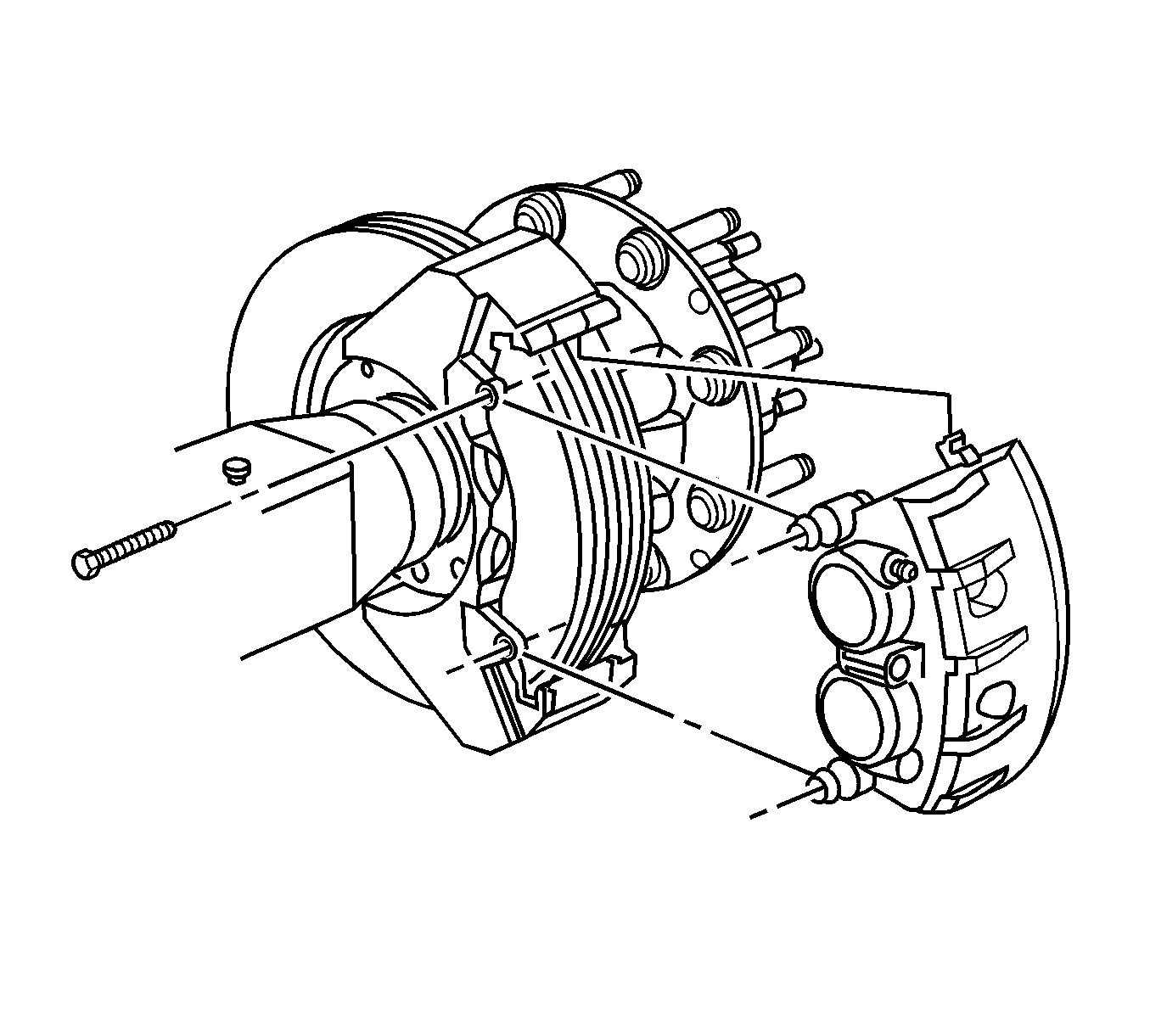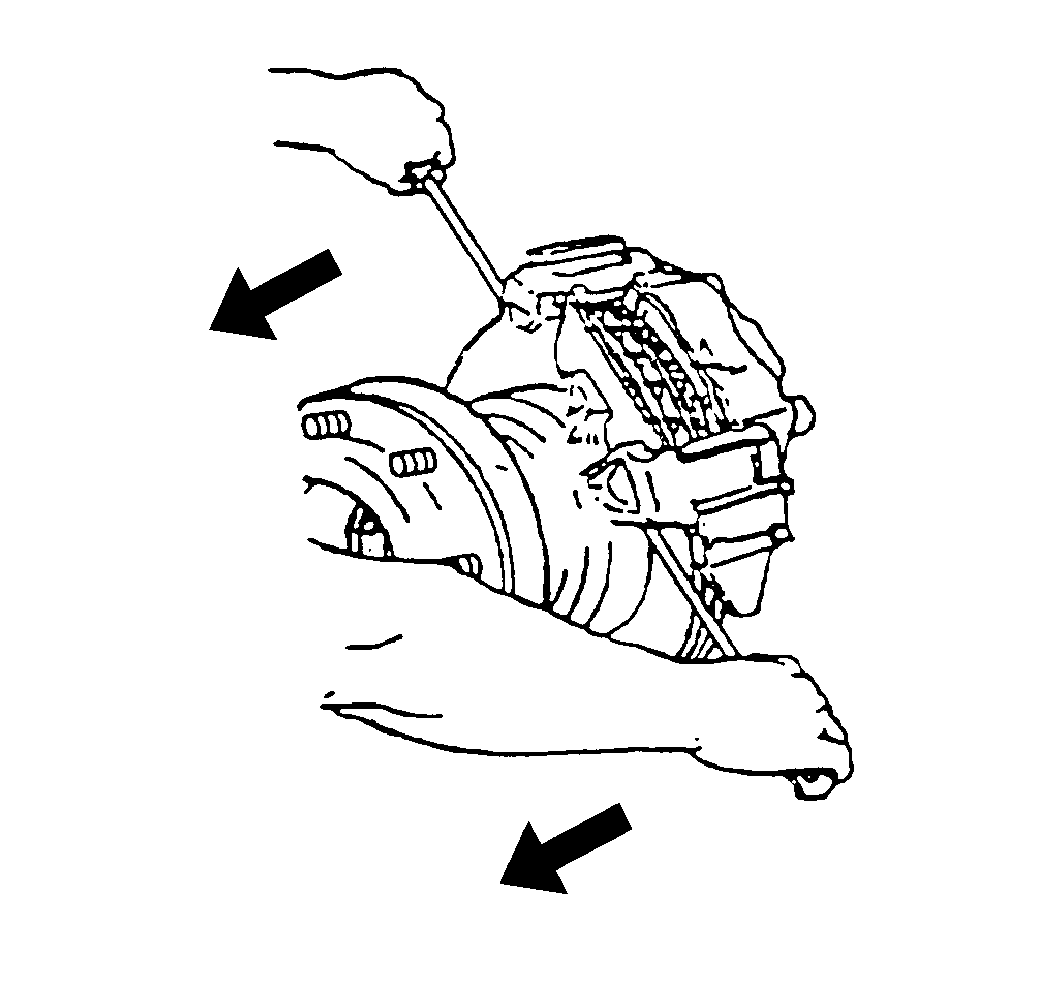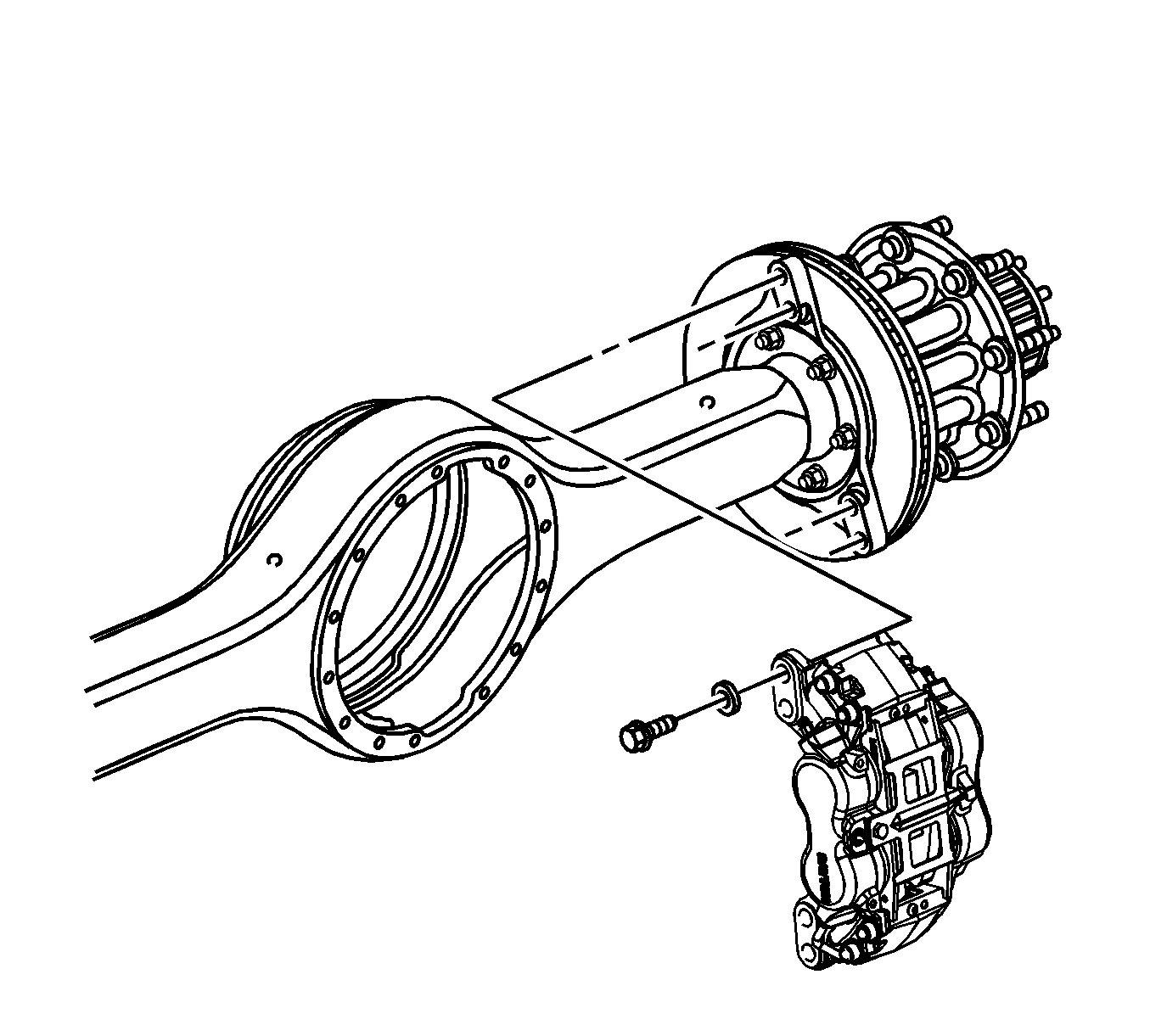Rear Brake Caliper Replacement TRW Pin Slider
Tools Required
J 44959 T-70 Torx Bit Socket
Caution: Refer to Brake Dust Caution in the Preface section.
Caution: Refer to Brake Fluid Irritant Caution in the Preface section.
Removal Procedure
- Apply the parking brake.
- Block the wheels.
- Remove about 2/3 of the brake fluid from the master cylinder reservoir.
- Raise the vehicle. Support the vehicle with safety stands. Refer to Lifting and Jacking the Vehicle.
- Remove the tire and wheel assembly. Refer to Tire and Wheel Removal and Installation.
- If the rotor removal is needed remove caliper with bracket.
- If equipped with a torx bit, remove the brake caliper mounting bolts using a J 44959 .
- Compress the piston using 2 screwdrivers to pry between the outer brake caliper housing and the outer brake pad.
- While compressing the pistons, watch the reservoir for possible brake fluid overflow.
- Disconnect the brake hose.
- Cap or tape the brake hose fitting in order to prevent contamination.
- Remove the brake caliper.
Important:
• Do not completely drain the master cylinder reservoir. • Drain the fluid from the brake caliper bleeder valve. • Drain the fluid into a suitable container. Discard the fluid.




Notice: Support the brake caliper with heavy mechanic wire, or equivalent, whenever it is separated from its mount and the hydraulic flexible brake hose is still connected. Failure to support the caliper in this manner will cause the flexible brake hose to bear the weight of the caliper, which may cause damage to the brake hose and in turn may cause a brake fluid leak.
Installation Procedure
- Apply a thin coat of brake caliper lubricant GM P/N 89021536 (Canadian P/N 89021538) or equivalent, to the brake caliper support pin surfaces.
- Install the brake hose.
- Loosely assemble the brake hose nut to the brake caliper.
- Install the wheel speed sensor. Refer to Rear Wheel Speed Sensor Replacement.
- If the brake caliper was removed with bracket, install the bracket.
- Install the brake caliper.
- Install the brake caliper mounting bolts.
- Fill the master cylinder reservoir with brake fluid. Use brake fluid GM P/N 1052535, or equivalent. Refer to Master Cylinder Reservoir Filling.
- Bleed the hydraulic brake system. Refer to Hydraulic Brake System Bleeding.
- Pump the brake pedal several times in order to ensure that the pedal is firm and the brake linings are seated.
- Install the tire and wheel assembly. Refer to Tire and Wheel Removal and Installation.
- Lower the vehicle. Refer to Lifting and Jacking the Vehicle.
- Remove the wheel blocks.
Notice: Refer to Installing Hoses without Twists or Bends Notice in the Preface section.
Notice: Refer to Fastener Notice in the Preface section.

Tighten
Tighten the bracket mounting bolts to 450 N·m (332 lb ft).

Tighten
Tighten the mounting bolts to 63 N·m (46 lb ft).
Important: Inspect the fluid level in the master cylinder reservoir after pumping the brake pedal.
Rear Brake Caliper Replacement Dayton-Walther Fixed Mount
Removal Procedure
- Apply the parking brake.
- Block the wheels.
- Remove about 2/3 of the brake fluid from the master cylinder reservoir.
- Raise the vehicle. Support the vehicle with safety stands. Refer to Lifting and Jacking the Vehicle.
- Remove the tire and wheel assembly. Refer to Tire and Wheel Removal and Installation.
- Remove the brake pad retainer spring bolt.
- Remove the brake pad retainer spring.
- Push back the pistons on one side of the brake caliper.
- Remove the brake pad.
- Push back the pistons on the other side of the brake caliper.
- Remove the remaining brake pad.
- Remove the brake pipe clip nuts and washers from the rear axle housing studs.
- Remove the brake pipe bolt and 2 gaskets from the caliper.
- Cap or tape the brake pipe fitting in order to prevent contamination.
- Remove the brake caliper bolts and washers.
- Remove the brake caliper from the brake caliper mounting plate.
Important:
• Do not completely drain the master cylinder reservoir. • Drain the fluid from the brake caliper bleeder valve. • Drain the fluid into a suitable container. • Discard the fluid.
Notice: Refer to Brake Caliper Notice in the Preface section.


Notice: Do not loosen or remove the four bolts in the brake caliper bridge area. The brake caliper bridge bolts may become loose. If the bridge bolts become loose, replace the brake caliper. Failure to follow these instructions will cause damage to the brake caliper.
Installation Procedure
- Install the brake caliper onto the brake caliper mounting plate.
- Install the brake pipe clips onto the rear axle housing studs.
- Install the brake pipe clip washers and nuts onto the rear axle housing studs.
- Install the brake pipe gaskets and bolt.
- Install the brake pads.
- Install the brake pad retainer spring.
- Install the brake pad retainer spring bolt.
- Fill the master cylinder reservoir with brake fluid. Refer to Master Cylinder Reservoir Filling.
- Bleed the hydraulic brake system. Refer to Hydraulic Brake System Bleeding.
- Pump the brake pedal several times in order to ensure that the pedal is firm and the brake pads are seated.
- Install the tire and wheel assembly. Refer to Tire and Wheel Removal and Installation.
- Lower the vehicle. Refer to Lifting and Jacking the Vehicle.
- Remove the wheel blocks.

Notice: Use the correct fastener in the correct location. Replacement fasteners must be the correct part number for that application. Fasteners requiring replacement or fasteners requiring the use of thread locking compound or sealant are identified in the service procedure. Do not use paints, lubricants, or corrosion inhibitors on fasteners or fastener joint surfaces unless specified. These coatings affect fastener torque and joint clamping force and may damage the fastener. Use the correct tightening sequence and specifications when installing fasteners in order to avoid damage to parts and systems.
Tighten
Tighten the brake caliper bolts to 450 N·m (332 lb ft).
Tighten
Tighten the brake pipe clip nuts to 17 N·m (13 lb ft).
Tighten
Tighten the brake pipe bolt to 37 N·m (27 lb ft).

Tighten
Tighten the brake pad retainer spring bolt to 41 N·m (30 lb ft).
Important: Inspect the fluid level in the master cylinder reservoir after pumping the brake pedal.
Caution: Do not move the vehicle until a firm brake pedal is obtained. Failure to obtain a firm pedal before moving vehicle may result in personal injury.
